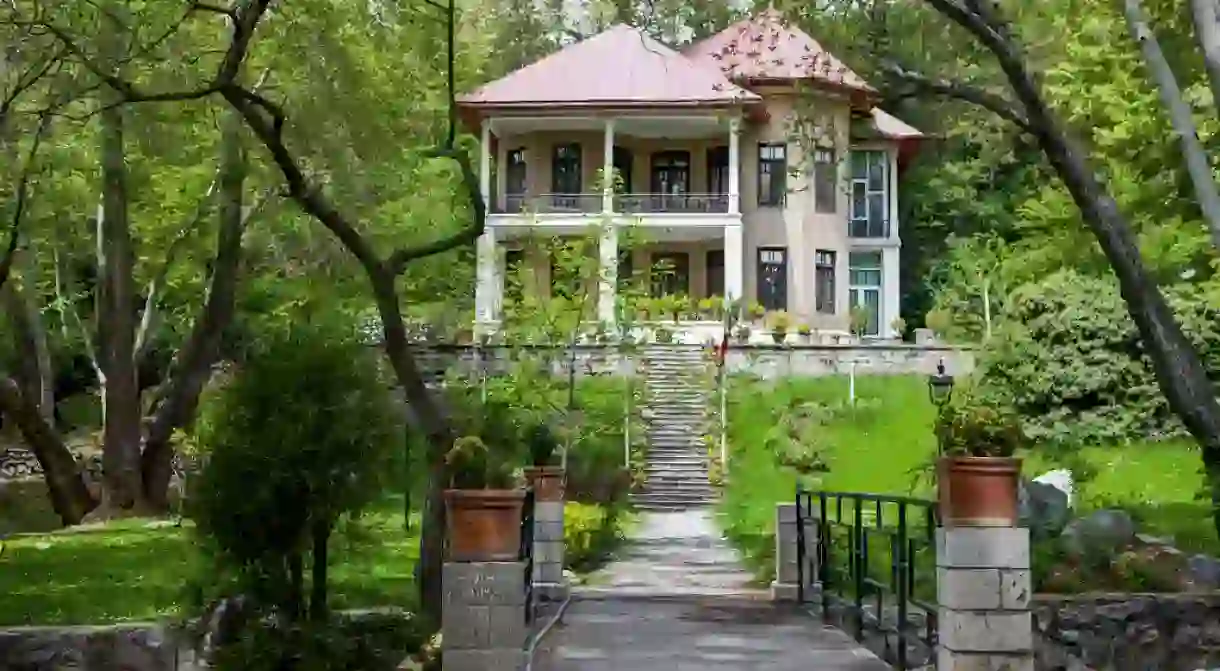How to Spend 48 Hours in Tehran, Iran

Most visitors spend little time in Tehran, and even locals recommend spending time in Iran’s more historical cities. Iran’s capital, however, has plenty of sightseeing opportunities to offer. This guide breaks down the best of what to do, see, and eat in 48 hours in Tehran.
You might also like: How The Iranian Horror Film ‘Under The Shadow’ Scared A Bunch of Critics
Day 1
Morning
Start your visit in Tehran with some history. The National Museum of Iran has an impressive collection spanning 30,000 years, including pottery, coins, and the recent addition of a 7,000-year-old woman’s skeleton (indicating that Tehran is much older than originally thought). Grab a tea or coffee along the cobblestone Si-e Tir Street for a mini-break before the next stop.
Head toward Imam Khomeini Square and walk down Naser Khosrow Street, one of the oldest streets in Tehran. Be greeted by Darolfonoon School, the first modern school in Iran, and the brilliantly diverse architecture of Saraye Roshan. Make a point to visit Golestan Palace, a UNESCO World Heritage site, whose Shams-ol-Emareh towers and clock are said to have been gifted by Queen Victoria. The seat of the Qajar dynasty’s government, this extravagant palace includes magnificent pools, grand mirrored halls, and fantastic mosaics. Don’t miss the masterpieces of painter Kamal ol-Molk displayed throughout the buildings.
National Museum of Iran, 30th Tir Ave and Emam Khomeini Ave, Tehran, Iran, +98 21 6670 2061
Golestan Palace, Panzdah-e Khordad Square, Tehran, Iran, +98 21 3311 3335

Afternoon
Across from Golestan Palace is Tehran’s Grand Bazaar. Wind your way through the maze of covered alleys that sell everything imaginable, from jewelry to rugs. Stop at Tehran’s smallest, century-old tea house, passed down from father to son, next to the bazaar’s mosque and Haj Abdollah School.
Leave the bazaar for lunch at Dizi Sarâ Iranshahr to enjoy one of Iran’s most authentic dishes, dizi: a delicious stew of potatoes, meat, tomatoes, and legumes cooked in a clay pot. Walk this satiating lunch off with a stroll down Iranshahr Street to the Iranian Artists’ Forum to people watch, catch a play, or check out contemporary art from local artists (you can also hop across the street to Assar Art Gallery).
Grand Bazaar, Panzdah-e Khordad Sq, Tehran, Iran
Dizi Sarâ Iranshahr, 52 Kalantari St, Tehran, Iran, +98 21 8881 0008
Iranian Artist’s Forum, Taleghani Ave N Mousavi, Tehran, Iran, +98 21 8831 0457

Evening
Laleh Park holds a few options to suit different moods. Art enthusiasts won’t want to miss the Tehran Museum of Contemporary Art—which houses the works of Monet, Pollack, and Rothko—or Laleh Gallery. The nearby Carpet Museum of Iran displays various patterns and styles of Persian carpets from all over Iran dating back to the 16th century. Feel like shopping? Laleh Bazaar offers all kinds of handmade products.
Tehran Museum of Contemporary Art, N Kargar St, Tehran, Iran, +98 21 8898 9374
Carpet Museum of Iran, Dr Fatemi St, Tehran, Iran, +98 21 8896 2703
Laleh Art Gallery, Dr Fatemi St, Tehran, Iran, +98 21 8896 0492

End the day by visiting Tehran’s iconic landmark, Azadi Tower—built in 1971, it has witnessed much of Iran’s history. Those with some energy left can take a taxi to Vanak Square for a delicious Persian dinner and traditional live music at Alighapoo Restaurant.
Azadi Tower, Azadi Square, Azadi St, Tehran, Iran, +98 21 6602 3951
Alighapoo Restaurant, 3 Gandhi St, Tehran, Iran, +98 21 8877 7803

Day 2
Morning
Start the day in northern Tehran at Sa’ad Abad Palace, the residence of the former Shah of Iran, which has since been converted to a complex of 18 museums of both history and fine art. Stroll through the lavish gardens and enjoy the fresh air and serenity before heading south toward Tajrish Square to visit Tajrish Bazaar, smaller and less hectic than the Grand Bazaar. The adjacent eye-catching shrine of Imamzadeh Saleh is also worth a visit. Walk down Valiasr Street, Tehran’s longest street, and make a pit stop for some tea at Ferdows Garden where the Qajar-era Cinema Museum is located.
Sa’ad Abad Palace Complex, Shahid Kamal Taheri St and Shahid Fallahi St, Tehran, Iran, +98 21 2275 2031
Tajrish Bazaar, Tajrish Square, Tehran, Iran
Cinema Museum, Bagh-e Ferdows, Valiasr St, Tehran. Iran, +98 21 2270 5005 9

Afternoon
Continue down Valiasr to stroll through the lovely Mellat Park, a peaceful respite in the middle of the city, before going to Tabiat Bridge. This multi-award-winning 270-meter (886-foot) architectural masterpiece connects two parks and quickly rivaled Azadi Tower and Milad Tower as the symbol of Tehran. Plenty of places here can satisfy your tummy after all that walking, but Khoone Restaurant, which changes its menu daily, offers the best traditional Iranian dishes in a home-style setting.
Tabiat Bridge, Modares Hwy, Tehran, Iran
Khoone Restaurant, Shahidi St and E Haqqani Hwy, Tehran, Iran, +98 21 4393 7

Evening
End your time in Tehran by visiting Milad Tower, which always has events going on from the time it opens until closing hours. Discover shops, get acquainted with wax figures of renowned Iranians, buy concert tickets, grab a bite to eat and, of course, take the elevator to the top and view Tehran from over 305 meters (1,000 feet)—something that will surely draw you back to the city for longer visit as soon as possible.
Milad Tower, Milad Tower Rd, Tehran, Iran, +98 21 8436 1000














